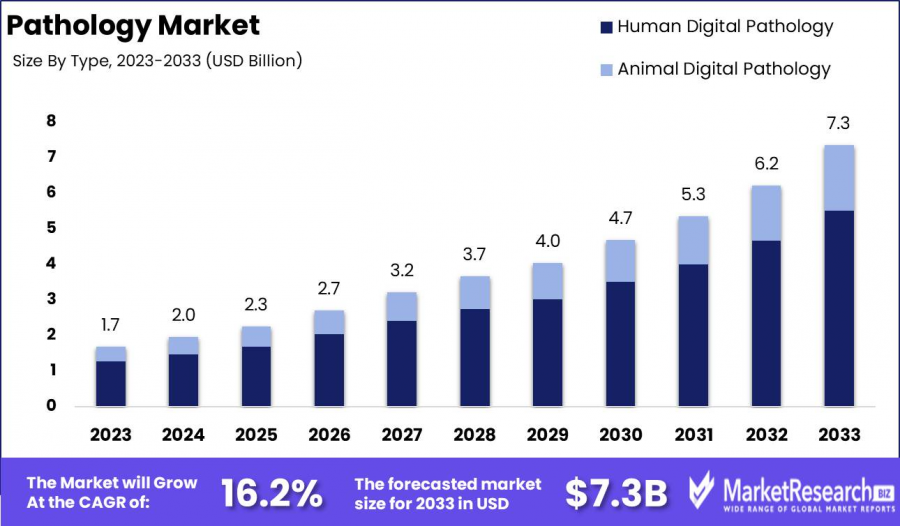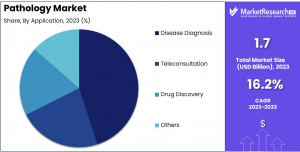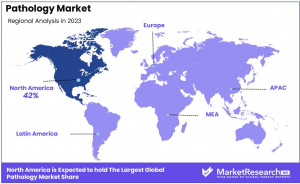
Pathology Market Expansion Accelerates, Anticipating USD 7.3 Billion Valuation by 2033
Pathology Market was valued at USD 1.7 Bn in 2023. It is expected to reach USD 7.3 Bn by 2033, with a CAGR of 16.2% during the forecast period from 2024 to 2033
NEW YORK, NY, UNITED STATES, February 17, 2025 /EINPresswire.com/ -- Overview
The Global Pathology Market was valued at USD 1.7 Bn in 2023. It is expected to reach USD 7.3 Bn by 2033, with a CAGR of 16.2% during the forecast period from 2024 to 2033.
Pathology is a medical specialty that focuses on diagnosing diseases by studying tissues, cells, and bodily fluids. It plays a crucial role in healthcare by identifying infections, cancers, genetic disorders, and other medical conditions. Pathologists use advanced techniques such as histopathology, cytology, molecular diagnostics, and immunohistochemistry to analyze specimens and guide treatment decisions.
There are two main branches of pathology: anatomical pathology, which examines tissues and organs, and clinical pathology, which analyzes blood, urine, and other fluids for abnormalities. Subspecialties include forensic pathology, microbiology, hematopathology, and neuropathology, each providing critical insights into disease mechanisms.
Pathology laboratories are essential for hospitals and research institutions, ensuring accurate diagnoses and early disease detection. Innovations in digital pathology and artificial intelligence are enhancing efficiency and precision, enabling remote analysis and automation. With rising healthcare demands, pathology continues to evolve, supporting personalized medicine and improving patient outcomes.
Click here to get a Sample report copy @ https://marketresearch.biz/report/pathology-market/request-sample/
Key Takeaways
•By Product: Scanners hold 20% of the market, highlighting their growing adoption in modern diagnostic workflows.
•By Type: Human digital pathology accounts for 75% of the market, reflecting the increasing shift toward digital diagnostics for improved accuracy.
•By Application: Disease diagnosis represents 50% of total applications, reinforcing its critical role in clinical pathology.
•By End User: Hospitals and reference laboratories contribute 45% of the market, underscoring their significance in diagnostic services.
•Regional Dominance: North America leads with a 42% market share, driven by cutting-edge technology and substantial healthcare investments.
•Growth Opportunity: The market is fueled by advancements in diagnostic technologies and a rising demand for early and precise disease detection.
Segmentation Analysis
••By Product Analysis: Scanners account for 20% of the product segment in the Pathology Market, holding a dominant position in 2023. Their importance is attributed to their role in digital pathology, enabling high-resolution imaging and efficient workflow integration. The demand for communication systems, storage solutions, and AI-driven software continues to rise, enhancing diagnostic accuracy. Additionally, instruments, consumables, and pathology services are crucial for laboratory operations, with ongoing advancements in microscopes, tissue processors, and laboratory management systems driving market growth.
••By Type Analysis: Human digital pathology dominates with 75% of the market, driven by the widespread adoption of digital diagnostics in healthcare. The segment focuses on tissue digitization for diagnostic and research purposes, integrating AI and machine learning for enhanced accuracy. Animal digital pathology, though smaller, is expanding in veterinary medicine, pharmaceutical research, and academic studies. The rising demand for advanced veterinary diagnostics and disease research is expected to drive substantial growth in this emerging segment.
••By Application Analysis: Disease diagnosis holds a 50% market share, underlining pathology’s critical role in detecting conditions like cancer, infectious diseases, and chronic illnesses. Teleconsultation is growing rapidly due to digital pathology and telemedicine, allowing remote consultations and second opinions. Drug discovery leverages pathology to evaluate disease mechanisms, drug efficacy, and safety. Other applications, including forensic pathology, academic research, and environmental pathology, further expand the market’s scope by supporting specialized diagnostic needs.
••By End User Analysis: Hospitals and reference laboratories represent 45% of the pathology market, providing comprehensive diagnostic services for patient care and clinical decision-making. The segment benefits from advanced technologies, telepathology, and digital pathology integration, enhancing diagnostic accuracy. Pharma and biotechnology companies utilize pathology for drug development, biomarker discovery, and clinical trials, driving innovation in personalized medicine. Academic and government research institutes contribute significantly by advancing new diagnostic techniques, disease studies, and pathology education, strengthening the overall market.
Market Segments
By Product
•Scanners
•Communication Systems
•Storage Systems
•Software
•Services
•Instruments
•Consumables
By Type
•Human Digital Pathology
•Animal Digital Pathology
By Application
•Disease Diagnosis
•Teleconsultation
•Drug Discovery
•Others
By End User
•Pharma and Biotechnology Companies
•Hospitals and Reference Laboratories
•Academic and Government Research Institutes
To Purchase this Premium Report @ https://marketresearch.biz/purchase-report/?report_id=47826
Market Dynamics
•Driver: The pathology market is primarily driven by technological advancements, notably the integration of artificial intelligence (AI) and digital pathology. These innovations enhance diagnostic accuracy and efficiency, addressing the global shortage of pathologists. For instance, AI-assisted diagnostics have been shown to increase pathologist productivity by up to 40%, facilitating faster disease identification and improved patient outcomes. The adoption of digital platforms enables remote consultations and seamless data sharing, further propelling market growth. These developments are crucial in meeting the rising demand for precise and timely diagnostic services worldwide.
•Trend: A significant trend in the pathology market is the shift towards outpatient and ambulatory care settings. This transition is driven by factors such as increased patient satisfaction, reduced healthcare costs, and improved productivity. Enhanced recovery protocols have enabled more complex procedures, traditionally performed in hospitals, to be conducted safely in outpatient settings. This trend necessitates adaptable pathology services capable of supporting decentralized healthcare delivery models, thereby influencing market dynamics and service provision strategies.
•Restraint: The pathology market faces challenges related to regulatory complexities and standardization. The lack of harmonized regulations across regions can impede the swift approval and adoption of new diagnostic technologies. Diverse regulatory requirements may lead to increased costs and delays, affecting the availability of advanced diagnostics. Additionally, ensuring the quality and safety of diagnostics necessitates robust pre-market evaluations and post-marketing controls, which can be resource-intensive. Addressing these regulatory hurdles is essential for the seamless integration of innovative solutions into clinical practice.
•Opportunity: The integration of AI predictive analytics presents a substantial opportunity in the pathology market. AI's capability to analyze extensive datasets, including electronic health records and imaging data, facilitates early disease detection and personalized treatment plans. Implementing AI-driven predictive models can enhance clinical decision-making, optimize resource allocation, and improve patient outcomes. As healthcare systems increasingly prioritize precision medicine, the adoption of AI technologies in pathology is poised to expand, offering avenues for innovation and improved diagnostic services.
Market Key Players
•Huron Digital Pathology Inc.
•microDimensions GmbH
•Apollo Enterprise Imaging
•Ventana Medical Systems Inc.
•Leica Biosystems Nussloch GMBH
•Indica Labs.
•Koninklijke Philips N.V. Healthcare
•Hamamatsu Photonics K.K
•Objective Pathology Services
•Omnyx LLC.
•3DHISTECH
•Corista
•Philips
•Leica Biosystems
•Mikroscan Technologies Inc.
•GE Healthcare
•Visiopharm
Regional Analysis
North America dominates the global pathology market, holding approximately 42% of the market share. This leadership is driven by advanced healthcare infrastructure, a high prevalence of chronic diseases, and significant research and development investments. The United States plays a key role, with numerous accredited laboratories and robust healthcare policies supporting the growth of pathology services.
Europe is another major player, with Germany, the UK, and France contributing significantly to the market. The region benefits from government healthcare initiatives, substantial funding for pathology research, and a strong focus on early disease detection. The integration of advanced diagnostic technologies further accelerates market expansion.
Asia Pacific is experiencing rapid growth, fueled by rising healthcare expenditures, increasing awareness of early disease diagnosis, and an aging population. The market is supported by expanding healthcare infrastructure and the adoption of modern diagnostic technologies, making it one of the fastest-growing regions.
Middle East & Africa is steadily expanding due to advancements in healthcare infrastructure and rising investments in medical research. The UAE and Saudi Arabia lead this market, with government initiatives focused on healthcare modernization and improved diagnostic services.
Latin America, led by Brazil, Mexico, and Argentina, is seeing steady growth due to increasing chronic disease prevalence and rising demand for advanced diagnostics. Government efforts to strengthen healthcare infrastructure and expand access to diagnostic technologies are key drivers of market expansion.
Emerging Trends in Pathology
•Digital Pathology: Traditional microscopy is being replaced by digital methods. Pathologists now analyze high-resolution digital images of tissue samples on computer screens. This shift enables easier storage, sharing, and detailed analysis of medical images. The adoption of digital pathology has been accelerated by the need for remote work solutions, especially highlighted during recent global events.
•Artificial Intelligence (AI) Integration: AI is becoming a vital tool in pathology. Advanced algorithms can detect patterns in tissue samples that might be challenging for the human eye, leading to faster and more accurate diagnoses. For instance, AI has shown promise in identifying metastatic breast cancer in lymph nodes with high accuracy.
•Molecular Pathology: This branch focuses on studying diseases at a molecular level, particularly genes and proteins. Techniques like in situ RNA sequencing allow for the examination of genetic material within preserved tissues, providing deeper insights into disease mechanisms.
•Telepathology: The practice of remote pathology consultation is on the rise. Digital platforms enable pathologists to share images and collaborate with peers worldwide, facilitating expert opinions without geographical constraints. A study in central India revealed that 98% of pathologists recognize the need for telepathology and digital pathology, with 51% anticipating increased use in the next five years.
Use Cases in Pathology
•Cancer Diagnosis and Prognosis: Pathologists play a crucial role in identifying cancer types and stages by examining tissue samples. Molecular pathology techniques can detect specific genetic mutations, aiding in personalized treatment plans. For example, identifying mutations in the EGFR gene can guide targeted therapies in lung cancer patients.
•Infectious Disease Detection: Pathology laboratories are essential in identifying pathogens causing infections. Molecular methods, such as polymerase chain reaction (PCR), can detect bacterial or viral DNA/RNA in patient samples, leading to prompt and accurate treatment decisions.
•Pharmaceutical Research and Clinical Trials: Digital pathology and image analysis enhance the accuracy and consistency of pathology assessments in clinical trials. These technologies enable precise measurement of tissue responses to new drugs, improving the reliability of trial outcomes.
•Educational Applications: Digital pathology serves as a valuable tool in medical education. High-quality digital slides can be shared among students and educators, facilitating interactive learning experiences. This approach allows for the examination of a wide range of cases without the need for physical slide handling.
Lawrence John
Prudour
91308 55334
Lawrence@prudour.com
Distribution channels: Healthcare & Pharmaceuticals Industry
Legal Disclaimer:
EIN Presswire provides this news content "as is" without warranty of any kind. We do not accept any responsibility or liability for the accuracy, content, images, videos, licenses, completeness, legality, or reliability of the information contained in this article. If you have any complaints or copyright issues related to this article, kindly contact the author above.
Submit your press release


